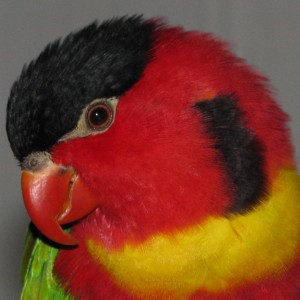

Join BirdNote tomorrow, November 30th!
Illustrator David Sibley and actor H. Jon Benjamin will face off in the bird illustration battle of the century during BirdNote's Year-end Celebration and Auction!
Keas are large alpine parrots from New Zealand. Intelligent and social, they have olive-green plumage, a red rump, and a long, curved beak. Keas produce a distinct warbling call, a “play call,” that sounds — and functions — much like a human’s contagious laughter. Scientists made recordings of captive Keas making warbling calls, then played them for wild Keas. They began playing harder and even engaged birds that hadn’t been playing. Hearing it seemed to put them in a playful mood, even when they were alone.
BirdNote®
Playful Keas Produce Contagious Laughter
Written by GrrlScientist
This is BirdNote.
[Kea “play call” recording: https://www.youtube.com/watch?v=_pKKc6p0M7Q]
“Laugh, and the world laughs with you,” is an old saying* that’s true for people — and for some parrots, too.
[Wild Kea calls from Raoul Schwing]
Keas [Pronounced KEE-uhz] are large alpine parrots that live on New Zealand's South Island. They’re the clowns of the parrot world. With olive-green plumage, a red rump, and a long, curved beak, these social birds are intelligent and playful.
When they’re playing, Keas produce a distinct warbling call, a “play call,” that sounds — and functions — much like contagious laughter in humans.
Scientists in Austria, who study how birds think and behave, wanted to test this idea. They recorded captive Keas making those warbling calls, then traveled to New Zealand where they played the recordings for wild Keas. Wild Keas that had been playing began playing harder and even engaged birds that had not been playing at all.
[Kea “play call” recording: https://www.youtube.com/watch?v=_pKKc6p0M7Q]
Scientists think the play call had an emotional effect on the birds. Hearing it seemed to put them in a playful mood, even when they were alone.
[Kea “play call” recording: https://www.youtube.com/watch?v=_pKKc6p0M7Q followed by human laughter: https://www.youtube.com/watch?v=0N374zrNbTY]
What’s your play call? Is it a referee’s whistle? The last school bell? Tell us what you hear — on our Facebook page, or at BirdNote.org.
I’m Mary McCann.
###
Bird sounds provided by Messerli Research Institute, University of Veterinary Medicine Vienna.
Recorded by Raoul Schwing.
BirdNote’s theme music was composed and played by Nancy Rumbel and John Kessler.
Producer: John Kessler
Managing Producer: Jason Saul
Associate Producer: Ellen Blackstone
© 2017 Tune In to Nature.org July/August 2017 July 2022 Narrator: Mary McCann
ID# kea-01-2017-08-30 kea-01
* From the poem Solitude, by Ella Wheeler Wilcox, 1883
read more: https://www.forbes.com/sites/grrlscientist/2017/03/24/playing-parrots-p…








